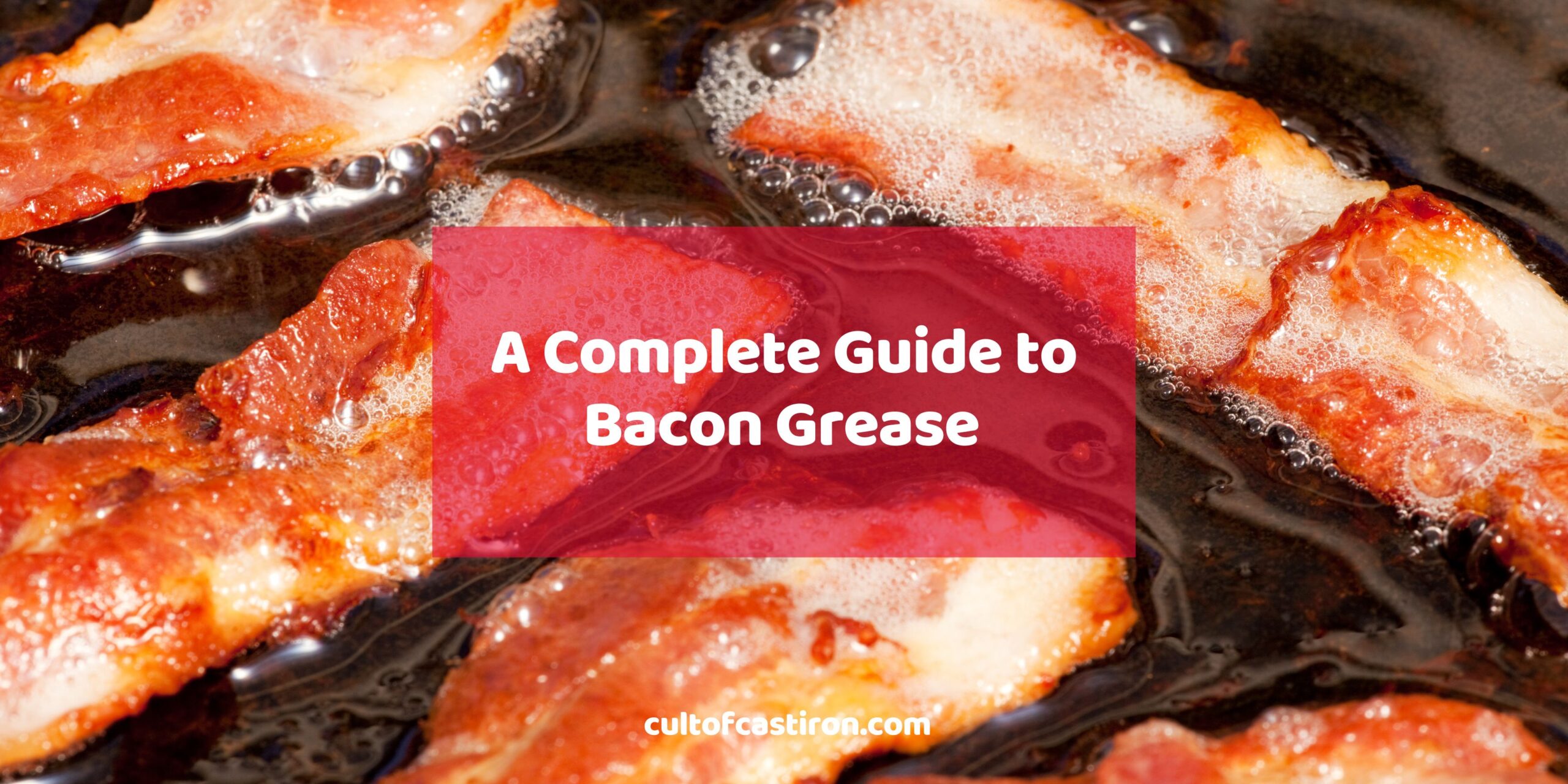Bacon grease is an incredibly versatile ingredient that can elevate your culinary game. Its rich flavor and unique fat composition adds some depth to your meals. Best of all, it is a free by-product that can be had after cooking bacon!
Curious to know more? Stick around as we delve into the art and science of collecting, storing, and making the most out of this culinary gem. But first, let’s discuss how best to render as much fat as you can from your bacon strips.
How to Render Bacon
Rendering bacon is a straight forward process – just cook the strips as usual, then you’ll have some bacon grease in your pan in no time. However, if you want to maximize the amount of bacon fat that you want to get, then you should follow these tips. We will discuss two ways to render bacon: the skillet method, and the bacon method. Let’s start with the skillet method.
The Skillet Method
Using a stovetop and cast iron skillet offers you greater control over temperature and allows for real-time adjustments. It is also a lot easier to transfer the rendered fat onto a separate vessel using a skillet compared to a drip pan. However, you may have to cook bacon in batches if you want to get a lot of bacon fat. With that said, this is the best method for everyday cooking.
Materials Needed
- Bacon strips
- Any type of skillet (I prefer cast iron, of course)
- Heat-safe container
- Funnel
- Mesh strainer
Step-by-Step Process of Render Bacon in a Cast Iron Skillet
- Start with a Cold Pan and Bacon: Place the bacon strips on your cast iron skillet before turning on the heat. As opposed to placing the bacon strips in a pre-heated pan, you should place the bacon while the pan is off the heat. Starting cold allows the fat to render out slowly, maximizing the amount you can collect, without burning the bacon.
- Low and Slow: Turn on the heat to a medium-low setting. Cooking bacon at a lower temperature for a longer time helps in rendering more fat, as opposed to quick, high-heat cooking.
- Flip Regularly: Make sure to flip the bacon strips every few minutes to ensure even cooking and more effective fat rendering.
- Transfer and Strain: Once the bacon is cooked to your liking, remove them from the pan. Then, carefully pour the hot grease through a mesh strainer into a heat-safe container, using a funnel if necessary.
The Oven Method
Using an oven to render the bacon is a great way to get large amounts of bacon grease in a relatively hands-off manner. However, things can get messy while transferring the pooled bacon grease in the drip pan into a smaller heat-safe container. This method is great if you want to intentionally make bacon grease.
Materials Needed
- Bacon strips
- Baking sheet
- Oven-safe wire rack (optional)
- Heat-safe container
- Funnel
- Mesh strainer
- Oven mitts
Step-by-Step Process of Rendering Bacon in an Oven
- Preheat the Oven: Preheat your oven to 375°F (190°C). Using the oven allows for a more hands-off approach compared to the stovetop.
- Prepare the Baking Sheet: Line a baking sheet with aluminum foil for easier cleanup. If you have an oven-safe wire rack, place it on top of the baking sheet. This allows the fat to drip down, making collection easier.
- Arrange the Bacon: Lay out the bacon strips on the baking sheet or wire rack, making sure they do not overlap. This ensures even rendering.
- Cook the Bacon: Place the baking sheet in the preheated oven and cook for 15-20 minutes. The time may vary based on the thickness of the bacon and your desired crispiness.
- Check Periodically: Every 5-7 minutes, check the bacon and the pooling grease. The goal is to render as much fat as possible without overcooking the bacon.
- Remove and Drain: Using oven mitts, carefully remove the baking sheet from the oven.
- Collect the Grease: Carefully pour the rendered fat from the baking sheet through a mesh strainer into a heat-safe container, using a funnel if necessary.
How to Increase Your Bacon Grease Yield
Now that you’re familiar with the general steps of bacon rendering, you should work on improving the amount and quality of your yield. Here are some tips and tricks to help you out:
1. Start with a thicker cut of bacon
Thicker bacon generally yields more fat but can be chewier, while thinner slices often render less fat but result in crispier end-product. If you can, opt for bacon with a higher fat-to-meat ratio. This will naturally give you more grease.
2. Use an oven to get purer bacon grease
While rendering bacon in a cast iron skillet is a perfectly acceptable course of action, oil used in the seasoning of the may mix with the rendered bacon grease. This is not going to be a problem for most, but those with discerning taste may want to keep the flavor profile pure. Unlike stovetop rendering, oven rendering rarely mixes bacon grease with other cooking oils, thus keeping your bacon grease purer.
3. Don’t go above bacon fat’s smoke point
Be mindful of the smoke point of bacon fat, which is around 370°F (188°C). Exceeding this can give the grease a burnt flavor. You should also note that the smoke point can vary depending on the quality and processing of the bacon.
4. Consider using semi-frozen bacon
Starting with semi-frozen bacon may seem unconventional, but this method has its merits when it comes to increasing the yield of rendered bacon grease. Here’s the science behind it:
The melting point of fat is lower than the temperature at which water evaporates. For example, lard starts melting at 30°C – 45°C (86°F – 113°F), while water starts evaporating at 100°C (212°F). Starting with semi-frozen bacon can help you reach the fat’s melting point more effectively without evaporating the water content too quickly, which means you can render the bacon longer without overcooking it.
How to Store Bacon Grease Safely
Storing bacon grease correctly is paramount for maintaining its flavor, quality, and safety. Improper storage can lead to spoilage or even bacterial growth. In this section, we delve into the best practices for storing bacon grease.
1. Let the bacon grease cool down
Before transferring the rendered grease into a suitable container, you should let it cool to a manageable temperature. Apart from safety from hot oil splatters, waiting for the temperature to cool down will prevent the bacon fat’s steam from producing condensation inside the glass. When left to its own devices, the moisture formed inside the glass will cause spoilage.
Also, When the grease is slightly cooled, it’s often easier to strain out the bacon bits and other impurities. This is because as the grease cools, it begins to thicken slightly, allowing the solid particles to settle at the bottom, which makes the straining process more efficient. However, make sure that the bacon fat won’t get cold enough to solidify, as this obviously makes straining a pain in the behind.
2. Set up your container
While you wait for the bacon grease to cool down, you set up the rest of your equipment for a quick and efficient process.
First, you should choose an appropriate container for the job. The tried and true classis is the glass mason jar. However, any glass jar with a tight-sealing lid will work as well. Avoid using plastic containers as they are quite reactive, and may absorb the bacon grease’s flavor.
Next, you should sanitize these containers to prevent spoilage especially for long term storage. The best way to do this is by washing the containers in soapy water. After rinsing off all of the soapy residue, you should then carefully submerge the glass container and its lid in boiling water for around 10 minutes to kill any bacteria and germs.
3. Pour the bacon grease into the container
Start the transferring process once the containers are ready. Get a funnel ready to avoid spillage.
With that said, don’t just pour the rendered fat into the container – you should also strain any impurities away. Filtering is a crucial step in preserving the quality of your rendered bacon grease. The tool you use for this—whether a cheesecloth or a metal mesh strainer—can impact both the clarity and flavor of the grease.
A metal mesh strainer is a practical choice. However, its larger holes will allow some minute particles to push through. Not only does this make the oil less clear and pure, it could also affect its flavor and its shelf life. Using a cheesecloth will produce better results, as its fine weave effectively filters out even the smallest particles.
4. Label and date the container
After pouring all of the grease into the container, I leave it slightly uncovered to let it cool down further to prevent it from fogging up inside, as we’ve discussed in the first section. This is a great time to put a label on the container to keep track of its age.
How long does bacon grease last?
Bacon grease freezes well, but I recommend using it immediately or within the next few weeks to enjoy it in its best quality. According to experts, fatty pork meat, or pork fat, should not be stored longer than 3–4 months at −18°C (64.4°F).
5. Store the container in a suitable location
It should go without saying that you should not keep bacon grease at room temperature as it can quickly go rancid. If you are going to use it frequently, I suggest that you store it inside the fridge, and use it within weeks. Freezing bacon fat is also a good way to extend its shelf life, but again, this is not an indefinite type of solution.
Be aware that bacon grease will go bad at some point. A rancid smell is the most noticeable sign that the bacon grease has already gone bad. Fresh bacon fat should have a rich, smoky aroma. If it smells sour or similar to paint, it’s likely rancid. It will also taste unpleasantly bitter. With that said, it is best not to F— around and find out. Trust your nose; if it doesn’t smell right, it probably isn’t.
Conclusion
Saving bacon grease is a great way of maximizing your resources and letting none go to waste. By following the steps outlined, you can safely collect and store this underrated by product for future use . And with your trusty cast iron skillet, I know that you can effectively use this bacon grease to elevate your home cooking, making the most of its rich, smoky essence
To learn more about cooking with cast iron, check out Cult of Cast Iron! Scroll through our blog dedicated to all things cast iron and find helpful tips and tricks to level up your cast iron skills! Discover a whole new world of cooking and spread the Cult of Cast Iron word today!

Miguel is a cast iron enthusiast from Cavite, Philippines. He works in the digital marketing field as a content marketing strategist. On the side, he manages a small online bookstore and tends to his plants.

